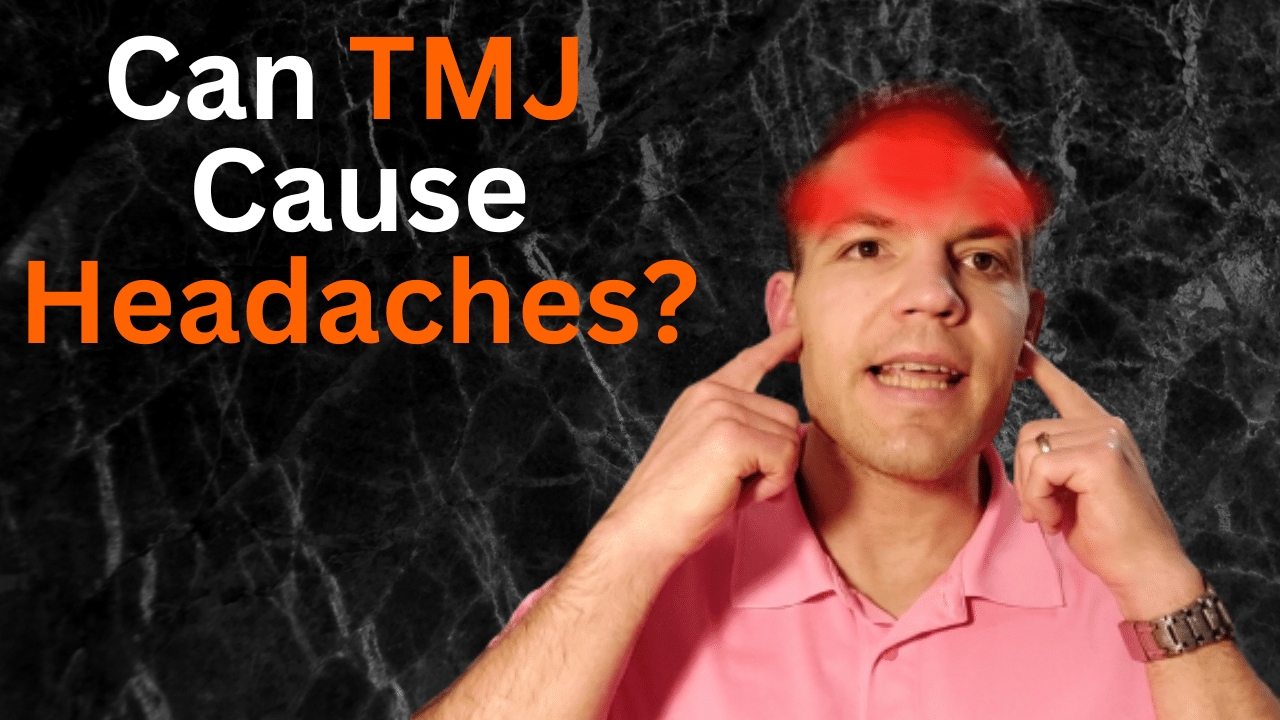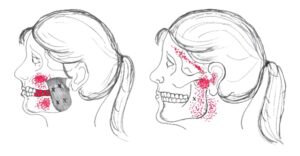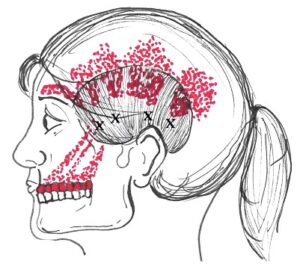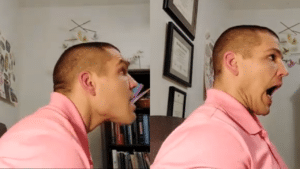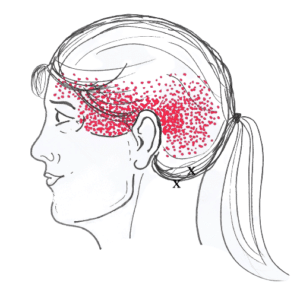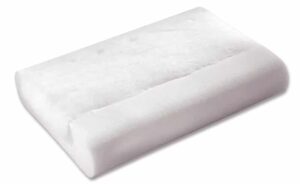One common question that I hear from patients is "Can TMJ cause headaches?"
Watch the video to learn 3 ways that TMJ can cause headaches, plus 3 tips to stop TMJ headaches.
Can TMJ Cause Headaches?
In short, TMJ can cause headaches.
In the rest of this post I'm going to answer the questions of:
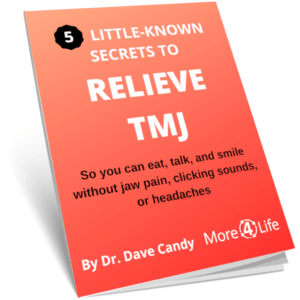
How Does TMJ Cause Headaches?
TMJ can cause headache in a number of ways.
However, from treating numerous patients with temporomandibular joint dysfunction (TMJ / TMD) over the years, I've found that these are the three most common ways that TMJ can cause headaches.
3 Ways TMJ Can Cause Headaches
- Trigger Points In Your Jaw Muscles
- Trigeminal Nerve Sensitization
- Poor Posture
Trigger Points In Your Jaw Muscles
Trigger points in your masseter muscle can refer pain up into the side of your head and forehead.
Additionally, your temporalis muscle, another muscle that you use for chewing can refer pain in to the side of your head.
If you clench your teeth a lot or grind your teeth at night, that can cause some tension in those muscles... both in the master as well as in the temporalis.
Those can give you symptoms that many people mistake for a primary headache, meaning a headache that is the disease in and of itself.
However, TMJ headaches are secondary headaches, meaning they're caused by something else... in this case trigger points in your jaw muscles.
In fact, many people with TMJ initially get misdiagnosed because sometimes the first symptom to present is a chronic headache.
We'll get to tips on how to solve these types of headaches a little later in the post.
So what's the second cause of TMJ headaches?
Trigeminal Neuralgia
Your trigeminal nerve is your fifth cranial nerve (CN V). It comes directly off of the brainstem and has three branches supplying your forehead, upper jaw, and lower jaw.
As you can see the first branch of the trigeminal nerve, the opthalmic branch (CN V-1), supplies the forehead while the maxillary branceh (CN V-2) supplies the upper jaw, and the mandibular branch (CN V-3) supplies the lower jaw or mandible.
You'll also notice the main trunk of the trigeminal nerve branches right in front of the ear near the TMJ. That's why TMJ can cause headaches from trigeminal neuralgia.
Poor Posture
The third cause of headaches from TMJ actually has nothing to do with the TMJ itself, at least not directly
Poor posture is a major cause of both TMJ and headaches.
So it's not so much of a case of "A causes B" where TMJ is A and headaches are B.
It's more a case of "C causes both A and B" where poor posture is a common cause of both TMJ and headaches.
You'll notice when you sit with a forward head posture as shown below, you can't open your jaw nearly as wide as when sitting upright.
Additionally, when you sit upright, your spine holds the weight of your head through it's bone structure.
However, when you sit with a forward head, the suboccipital muscles at the base of your skull have to work really hard to hold your head upright.
There's a nerve called the occipital nerve that runs through those muscles which can get irritated when sitting with poor posture.
In addition, trigger points in your suboccipital muscles can actually cause headaches at the base of your skull or in your forehead.
So now that you know how TMJ can cause headaches, that begs the question:
How Can You Relieve TMJ Headaches?
Correct Posture
Let's start with the third cause that we discussed above as the first solution: posture. Correcting your posture is one of the easiest ways to relieve both headaches and TMJ.
And better yet, sometime it has almost immediate effects.
With more chronic cases, it may take awhile to see the effects, but just correcting your posture is a good start.
To do that, sit with your head above your shoulder with your chin tucked.
Sitting or standing in such a manner allows your spine to support the weight of your head instead of your suboccipital muscles.
Additionally, sitting with proper posture causes less tension in the jaw muscles as well as less compression on the tempormandibular joint itself.
Avoid Clenching Your Teeth
The second solution to TMJ headaches is to avoiding clenching your teeth.
That's kind of hard to do at night time when you can't control it.
There are TMJ mouthguards, and they're moderately successful for some people with TMJ.
However, the problem with mouthguards is that most people with TMJ find that when they use a bite guard, they just end up chewing down on the guard or wearing the guard down.
To truly stop TMJ at night, it's better to have a night splint made by a dentist who specializes in TMJ that'll keep your jaw in the correct position at nighttime.
Additionally, using a properly fit pillow to keep your head, neck, and jaw supported can help keep your jaw in the proper alignment at night.
Here is one pillow that I recommend to patients that has a 4-in-1 fit design so that it works for most people without having to get into custom fit pillows.
Pillopedic Pillow
Click Here To Buy
During the daytime though, you have a little more control over what you do with your jaw.
Here's a helpful tip that you can use to keep from clenching your teeth during the day and therefore prevent TMJ headaches.
When you're sitting, place your your tongue behind your top teethwhen you're not talking or eating.
When you rest your tongue behind your top teeth, it makes it really hard to clench your jaw muscles at the same time.
Trigger Point Release
The third thing you can do to relieve TMJ headaches is doing some self trigger point release.
I mentioned earlier that trigger points in the master muscle as well as in the temporalis muscle they can cause symptoms of a headache.
Therefore, if you can locate the "knots" or "trigger points" in the masseter and temporalis muscles, and hold a gentle pressure on them, you can get the muscles to relax.
Just hold a gentle pressure on the muscles. You don't want to hold so much pressure that it's causing you a lot of pain.
Your TMJ or headaches should not feel worse after doing this!
It might be a little bit uncomfortable while you're actually pushing on the muscles, but you should feel better, or at least no worse after you're done.
Watch the video above for more specific directions on how to do trigger point release for the masseter and temporalis muscles.
Need Help For TMJ Headaches?
If you try these tips and you're still having some trouble seeing a physical therapist who specializes in TMJ can be helpful.
We happen to specialize in TMJ physical therapy here at More 4 Life.
If you'd like to schedule an appointment with one of our specialist physical therapists to find out how we can help your TMJ or headaches, just tap the button below.

